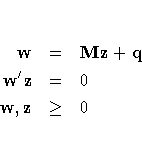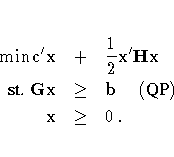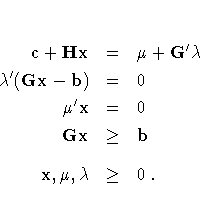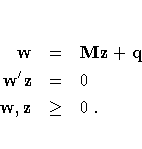Chapter Contents
Previous
Next
|
Chapter Contents |
Previous |
Next |
| Language Reference |

q={1, 1};
m={1 0,
0 1};
call lcp(rc,w,z,m,q);
The result is
RC 1 row 1 col (numeric)
0
W 2 rows 1 col (numeric)
1
1
Z 2 rows 1 col (numeric)
0
0
The next example shows the relationship between quadratic
programming and the linear complementarity problem.
Consider the linearly constrained quadratic program:


![M & = & [ H & -G^' \ G & 0 \ ] \w^' & = & ({\mu }^'s^') \z^' & = & (x^'{\lambda}^') \q^' & = & (c^' - b) .](images/i17eq182.gif)

![C^' & = & (1 2 4 5)
B^' = ( 1 1 ) \
H & = & [ 100 & 10 & 1 & 0 \ 10 & 100 & 1...
... & 10 \ 0 & 1 & 10 & 100
] \
G & = & [ 1 & 2 & 3 & 4 \ 10 & 20 & 30 & 40
] \](images/i17eq185.gif)
/*---- Data for the Quadratic Program -----*/
c={1,2,3,4};
h={100 10 1 0, 10 100 10 1, 1 10 100 10, 0 1 10 100};
g={1 2 3 4, 10 20 30 40};
b={1, 1};
/*----- Express the Kuhn-Tucker Conditions as an LCP ----*/
m=h||-g^{\prime} ;
m=m//(g||j(nrow(g),nrow(g),0));
q=c//-b ;
/*----- Solve for a Kuhn-Tucker Point --------*/
call lcp(rc,w,z,m,q);
/*------ Extract the Solution to the Quadratic Program ----*/
x=z[1:nrow(h)];
print rc x;
The printed solution is
RC 1 row 1 col (numeric)
0
X 4 rows 1 col (numeric)
0.0307522
0.0619692
0.0929721
0.1415983
|
Chapter Contents |
Previous |
Next |
Top |
Copyright © 1999 by SAS Institute Inc., Cary, NC, USA. All rights reserved.